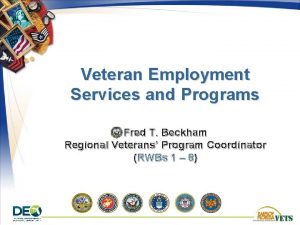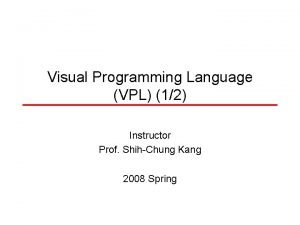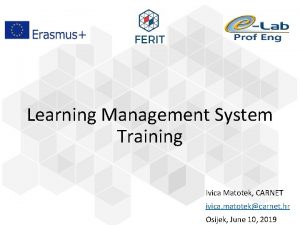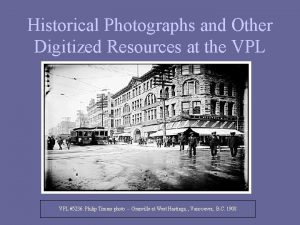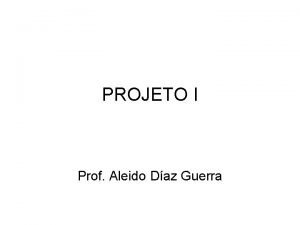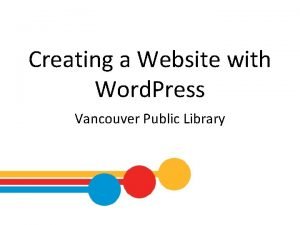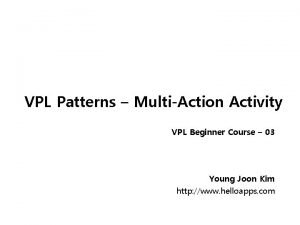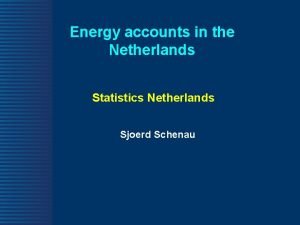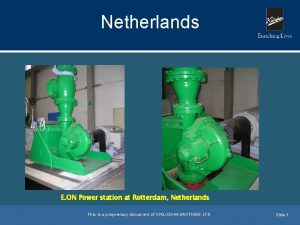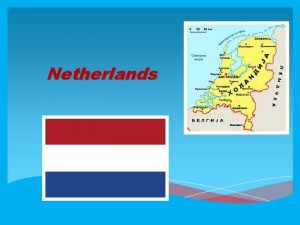Quality Code on VPL in The Netherlands VPL













- Slides: 13

Quality Code on VPL in The Netherlands VPL Biennale, Rotterdam 9 -11 April 2014 Patrick Leushuis Ministry of Education, Culture and Science

VPL in The Netherlands (1) 1994, Committee Wijnen: validation of non-formal learning Follow up: small scale pilots and experiments 1998, Thesis Dr. Klarus: validation of competences 2000, Department of Economic Affairs: working group => publication ‘The bottle is half full’ • 2001, National Expertise Center VPL => learn from VPL practice & promote use of VPL • • • Perspective slowly changed: Ø from transparancy in learning outcomes of non-formal learning and connecting learning outcomes of non-formal and formal learning Ø to emloyability, career development and lifelong learning 2

VPL in The Netherlands (2) 2000 -2005: • Growing VPL practice • Huge diversity in procedures, instruments & quality => Ø demand for clarity & quality Ø demand for promotion of VPL and lifelong learning 2006: • National Quality Code on VPL • Agreement between social partners, government & education 3

National Quality Code on VPL (1) • Quality criteria regarding: Ø aims Ø rights & information Ø assessment instruments & criteria Ø quality of counsellors and assessors Ø QA by VPL providers • VPL = instrument for individual career development Ø directly at the labour market Ø through education and training: exemptions etc. VPL assessment standards Ø formal educational standards VET and HE Ø non-formal standards branches of industry 4

National Quality Code on VPL (2) VPL = market activity Independent VPL providers Ø Accessibility Ø Reliability Accreditation of VPL standards, procedures & providers Ø External audit organizations National VPL register Tax deductibility of costs for VPL 5

National Expertise Center VPL • Information on VPL and quality code • Good practices • VPL academy: Ø training VPL-professionals Ø training exam committees • VPL toolbox: Ø Handbooks & guidelines Ø competence profiles counsellors and assessors => Focus on summative assessment and quality assurance 6

Building the VPL-infrastructure • Subsidies for regional partnerships learning & working (20062010): Ø businesses, education & training institutes, local and regional government organizations Ø VPL and work based learning (WBL) • Subsidies for higher education institutes (2007 -2011) • Regional learning & working offices (since 2010) Ø physical & virtual ‘front offices’ Ø active approach of employers 7

Promotion of VPL • Booklets, flyers, posters etc. • Portal and websites Ø Animation clip: http: //www. youtube. com/watch? v=_BZWyh 52 RCk&feature =related Ø Videos – VPL testimonials etc. : video. ervaringscertificaat. nl • National campaigns: TV, radio, internet Ø TV add: www. youtube. com/watch? v=z. Cf 4 ud. F_Eu. A • Social partners (employers organizations and unions): case studies on good VPL practices => VPL in collective labour agreements and sector plans 8

Results • Numbers of VPL-participants: 2007 - 9. 900 2008 - 12. 500 2009 - 15. 700 2010 - 22. 000 2011 - 17. 700 • About 120 VPL providers by 2010 • Mainly formal standards at EQF- levels 2, 3 and 4 • Increasing share of VPL-participants in procedures using non-formal standards 9

Evaluation: experiences and challenges (1) • VPL is mostly used as an instrument to obtain exemptions: Ø Educational enrollment & diploma orientation + Ø Direct use on labour market & career development – • Effects of VPL for individuals: Ø Changes in tasks, internal & external mobility Ø Income development Ø But only for those who obtained a formal qualification/diploma after their VPL procedure … • Challenges: Ø Reinforce the use of VPL on the labour market Ø Reinforce the use of ‘alternative’ instruments (formative) 10

Evaluation: experiences and challenges (2) • Inspection for VET / Higher Education: Ø Concerns about decision making exam committees Ø VPL reports often are not according to standards • Problems in transfer and acceptance of VPL reports • Market ‘shake out’ VPL providers: Ø High costs of accreditation Ø Numbers of VPL participants per standard are too low Ø Alternatives: intake assessments and exemption procedures 11

Towards a dual approach in VPL (1) 2013, social partners and government => analysis + proposal: Ø Dual system: 1. VPL in labour market 2. VPL in formal education Ø VPL in labour market: v promote the use of a variety in instruments & standards v promote integration in HRM policies & practice Ø Quality assurance: v no longer a ‘one size fits all’ quality code on VPL v VPL in labour market: QA ‘fit for purpose’ v VPL in formal education: QA VPL in regular QA education Connection non-formal and formal standards: learning outcomes 12

Towards a dual approach in VPL (2) Planning: 2014: implementation plan 2014/2015: transitional phase 2016: implementation Issues: • National validation authority? • VPL in labour market: Ø Quality Code / QA-system: only related to summative use Ø Development and use of national / sectoral qualifications Ø Promotion of use of variety of instruments & integration Ø Responsibility: v Social partners at national level? v Sectoral employers organisations? v Government role (Min. Social Affairs / Economic Affairs)? 13

